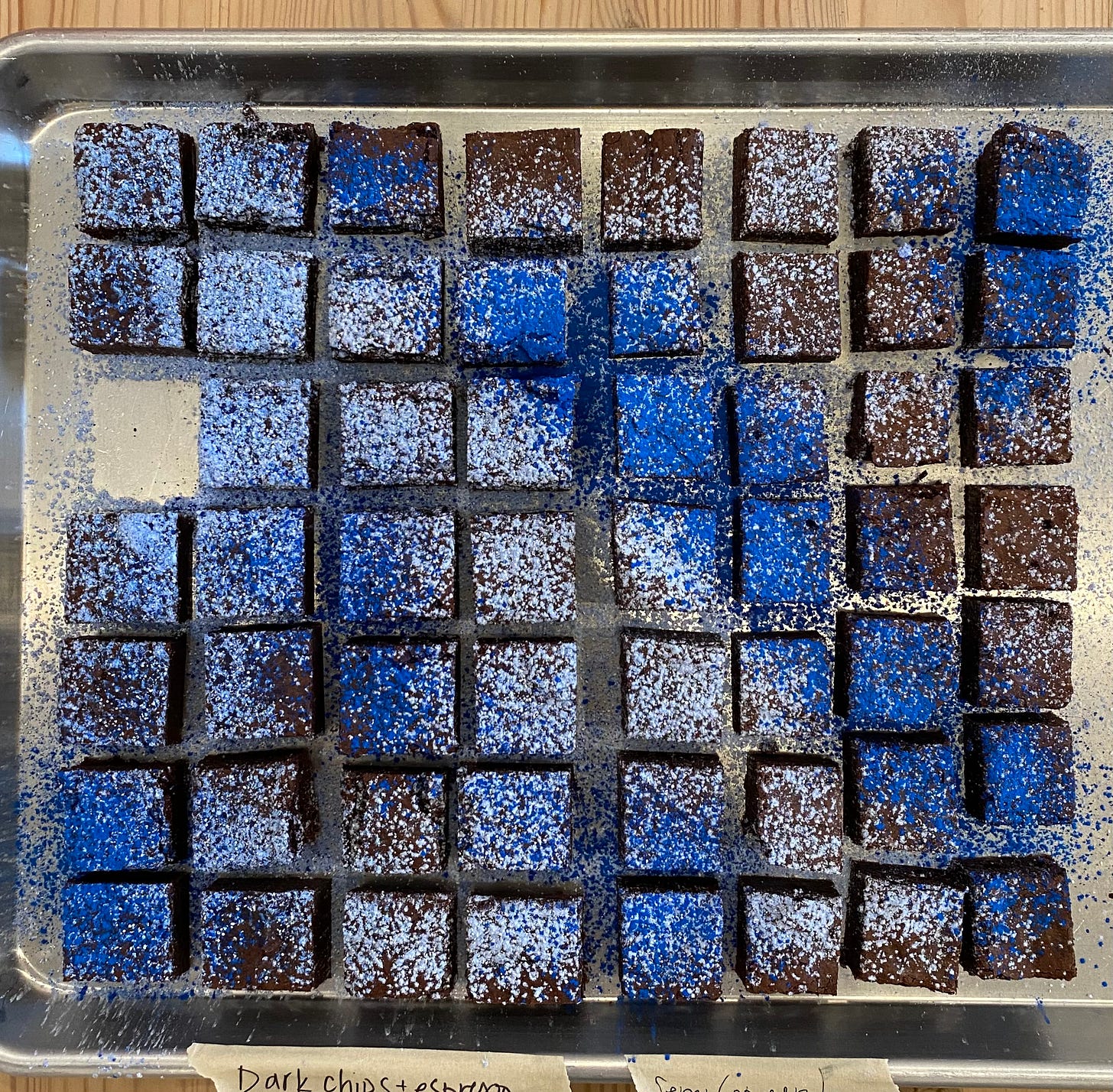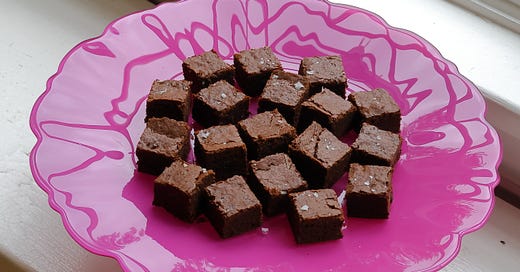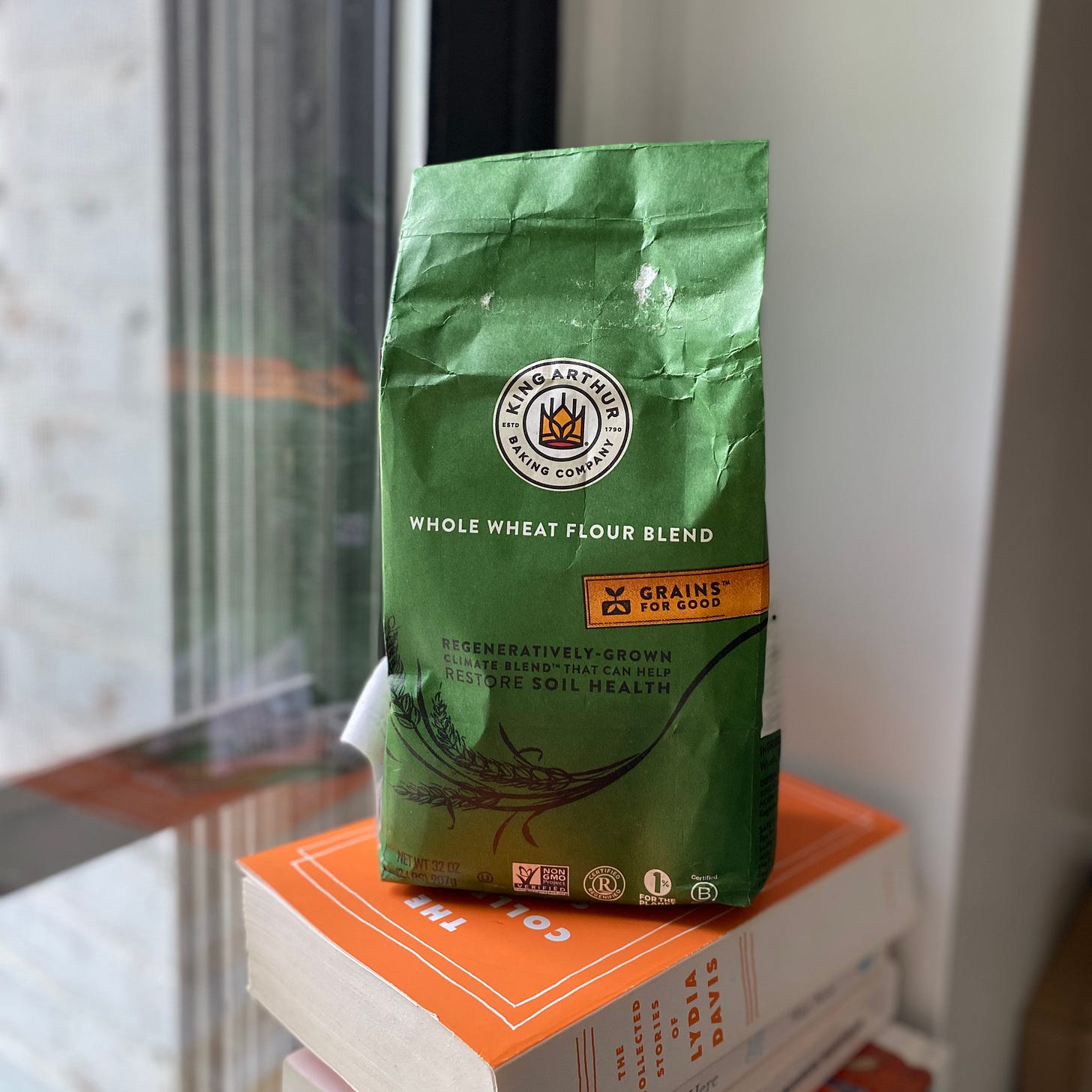Could a dessert menu tell us a lil somethin’ about where our food system is today, and where it’s headed on its journey to sustainability? That’s the question I asked myself when I set out to develop a trio of climate-friendly treats to serve at this Canary Media event during Climate Week NYC next month.
When I began brainstorming, my mind immediately jumped to former White House chef Sam Kass’s ‘Last Supper,’ which featured several of life’s finer things that are at risk from climate change, like red wine, salmon, and coffee. It’s one of the cooler feats of climate gastronomy I’ve seen.
But I knew I wanted my dessert-y prophecy to lean more toward imagining the culinary path forward—the sweet solutions, if you will—as is our vibe hereabouts. The plan, in other words, is for a mini dessert menu that’s an excerpt of climate cuisine.
I’m in the process of developing these three dessert recipes now; and as I finish each one, I’m going to share it on Pale Blue Tart. Today, we begin with a “Climate Blend” brownie that can help restore the soil (srsly!), one exceedingly snarfable bite at a time.
The way industrial farming works in America may be great for producing high volumes of food, but it’s not great for the soil. The loss of topsoils—here and around the world—is the quiet environmental crisis, sometimes lost amidst the showier drama of climate change and extreme weather. But it’s a big deal: Planting row crops every year, dumping a bunch of fertilizers on them, harvesting them, tilling (or churning up) the ground, and then repeating that process ad nauseum, has depleted soils and made them prone to blowing or washing away in climate-fueled droughts and storms. The environmental writer Verlyn Klinkenborg likened this prevailing, industrial approach to agriculture to “slow strip-mining;” and it ultimately makes farmland not just more vulnerable to climate change, but less productive, too.
Enter regenerative farming, and King Arthur’s whole wheat Climate Blend flour. The Vermont-based flour company released this flour for the future, which was developed in partnership with the Washington State University Breadlab, late last year. It’s sold in two-pound bags on King Arthur’s website, at Whole Foods, and at select other grocery stores. The blend basically has two layers of climate resilience, as Bloomberg and Fast Company have reported.
The first is how it’s grown. All the wheat in the flour blend is grown on two farms in North Dakota and Montana that use regenerative practices. As I reported in one5c earlier this year, “regenerative” is a catch-all term for soil-improving practices, which can include minimizing or nixing tilling, reducing inputs like fertilizers, crop rotations, and cover cropping. These practices help the soil retain moisture and nutrients and avoid erosion—fab news for climate resilience. Leaving soils undisturbed also keeps carbon dioxide underground instead of releasing it into the atmosphere, which is why some proponents call this style of farming “carbon farming.” (Though fwiw, big questions remain about how much carbon agricultural lands can sequester, and for how long.)
The second climate-resilience advantage is in the actual varieties of wheat used. There are three, and the Breadlab—whose whole shtick is breeding climate-adapted grains that are more nutritious and that work well for farmers—developed them all. Two are hard red wheats, which is the same general variety used in most American flour. Another is a perennial wheat; and therein lies the big resilience boon, as Brian Kahn wrote in Bloomberg. Perennials grow back for two or three years, instead of needing to be replanted every single year. Their longevity further reduces the need to till and churn the soil.
This flour is also more climate-resilient than a conventional bag of all-purpose or whole wheat flour, because its contents are designed to vary a bit from year to year. Basically, the farmers can switch up the varieties if climate conditions cause some types of wheat to grow better during a given season than others.
Selling a flour that’s anything less than identical from one year to the next is a bold move in the extraordinarily rote American food system. But King Arthur’s VP of corporate social responsibility, Suzanne McDowell, told Fast Company that she isn’t worried bakers will balk at a flour lacking perpetual and total uniformity. It’s a chance to “build our muscles about baking in a more variable space,” she said.
Depending on your recipe, a little variability might actually be kind of cool. Take a plain, whole wheat scone, for instance, in which the flour is a starring flavor. EcoWatch writer Paige Bennett found that she could detect a teensy difference between a Climate Blend scone and a conventional whole wheat scone when she baked them side by side; she preferred the Climate scone’s extra richness and nuttiness. I can imagine a bakery proudly pointing out the slight flavor differences in their scones or sourdough from one season to the next. How different is that, really, from the way we expect and celebrate slight flavor differences in chocolate, tomatoes, peaches?

There are also recipes, like the brownie I developed, in which any slight variability doesn’t actually matter, because flour disappears completely into the background. My taste-testers didn’t know this brownie was made with 100% whole wheat flour, much less a climate-friendly variation on whole wheat, until I told them. (One taster described it as “a box-mix brownie, but better,” which is basically the highest praise this silly lil climate treat could have received.)
Brownies are among the logical recipes to start with if you want to do your own experimentation with this resilient flour, said Alexander B., a baker support specialist with the King Arthur Baker’s Hotline, when I called him up last week for tips on working Climate Blend into your baking routine. He recommended reading the company’s guide to Climate Blend, which includes practical advice like: Use 50% Climate Blend in most recipes that call for all-purpose, or 25% in particularly light-textured bakes, such as cakes. Alexander also offered a shortcut to knowing how much Climate Blend to sub in for all-purpose: “I would think about how high you want the rise to be,” he told me. For loftier bakes, like sourdough bread or cakes, use less. For flattish bakes, use a higher percentage, or go whole hog (as I did). “Something like brownies or cookies are very safe items to just jump right in and substitute flours in general."
The ultimate, soil-saving brownie
These brownies are fudgy, chewy, and darkly elegant—kind of like a boxed brownie that gussied itself up for a cocktail party. It’s a brownie that—as I found through extensive testing and spreadsheeting—splits the difference between Lidey Heuck’s brownie and Thomas Keller’s brownie in terms of the chocolate to everything-else ratios. (I adapted this recipe most closely from Lidey’s, subbing Climate Blend for all-purpose flour, adding 50 percent more chocolate for a smidge more fudginess, increasing the baking powder to keep the whole-wheat-ier flour and extra chocolate aloft, and adding an optional-but-recommended dash of espresso powder and flaky salt). Because these brownies are made with King Arthur’s regeneratively grown Climate Blend flour, every bite is a boon for the soil. The espresso powder and flaky salt are optional, but recommended. If you like extra neat squares like I do, let the brownies cool to room temperature and then chill them in the fridge several hours before slicing, wiping the knife clean between each slice.
Makes 9-12 standard brownies, or three dozen one-inch brownie bites
Ingredients
½ cup (1 stick, or 113g) unsalted butter, cut into chunks
1 cup (200g) sugar
¾ cup (129g) bittersweet or semi-sweet chocolate chips
2 eggs
1 teaspoon vanilla
½ cup (57g) Climate Blend flour
½ cup (42g) cocoa powder
¼ teaspoon baking soda
¾ teaspoon kosher salt
½ teaspoon espresso powder, optional
Flaky salt for sprinkling, optional
Powdered sugar for sprinkling, optional
Preheat the oven to 325F. Spray an 8x8 square baking dish with baking spray and line it with parchment paper.
In a medium saucepan, combine butter and sugar. Cook over medium heat, stirring occasionally, until butter melts and a few bubbles appear. Remove the pan from heat and stir in the chocolate chips until they melt. Transfer the mixture to a mixing bowl and let it cool for a few minutes before you add the eggs.
Add the eggs and vanilla to the mixture and whisk until fully incorporated, smooth, and glossy, about 30 seconds.
In another bowl, whisk together the dry ingredients (the Climate Blend flour, cocoa powder, baking soda, kosher salt, and espresso powder, if using). Add the dry ingredients to the wet ingredients and fold together with a spatula until combined.
Transfer the mixture to the prepared baking pan. If you’re persnickety like me, smooth the batter with an offset spatula. If you’re well-adjusted, don’t. Sprinkle a bit of flaky salt over the batter, if using. Bake for 33-40 minutes, or until a toothpick inserted into the center of the brownies comes out with just a few moist crumbs on it. Allow to cool to room temperature before cutting. Brownies will keep, wrapped well or in an airtight container, for 3 days, or for eons in the freezer.
An extra helping
Play around with Climate Blend flour. (Not sponsored!) It’s a fairly pricey proof of concept—it’s double the cost of King Arthur’s standard whole wheat and a hair more expensive than their organic version—but it’s on sale right now for $4.98/2-lb bag.
Bake other recipes using Climate Blend, like King Arthur’s chapati and whole wheat scones.
Get on the waitlist for the Canary Media event on September 23rd so I can feed you these brownies! John Kerry will be there, and you can help me corral him and his gaping maw toward my dessert table!
Read my story on vegan cheese that came out in Grist on Friday. It’s totally unrelated to this newsletter edition, but I’m just really excited that it’s finally out. I was as nitpicky as humanly possible in my vegan cheese reviews, because the whole point of climate cuisine is that it! has! to! taste! good!








Omg! The flour is out of stock right now, but I'm soooo excited to stock my pantry with it when it's back in stock.
It would be much more climate friendly to not use eggs, and instead use aquafaba, applesauce, or flax seed.